Cinema scope: ifs, buts, and director’s cuts
On March 18, 2021, “Zack Snyder’s Justice League,” a director’s cut of 2017’s “Justice League,” was released on HBO Max. This came after years of online fans incessantly campaigning with the hashtag #ReleaseTheSnyderCut. Desperate for content for their streaming service amidst the pandemic, Warner Bros. Pictures gave director Zack Snyder $70 million to complete his original film.
The original 2017 film, though directed by Snyder in name, was subjected to heavy studio interference. Following Snyder’s exit from the project for personal reasons, interim director Joss Whedon came onto the project for heavy rewrites and a change in direction.
Four years later, after a frenzy of fan outrage and advocacy from the director himself, Zack Snyder’s “original vision” in the four-hour behemoth that is “Zack Snyder’s Justice League” was shown to the world. The film, though critically received better than the previous film, was bloated and elucidated the problems plaguing modern director’s cuts.
Director cuts did not always get a bad rap. Until recently, director’s cuts provided a unique opportunity not often lent to filmmakers: full creative control. While a studio might meddle with the final product shown in theaters, directors could fully control the editing process for their own cut..
Perhaps the most infamous example of this is Ridley Scott’s 1982 film “Blade Runner.” Warner Bros. added a voiceover monologue and changed the ending in post-production to make the premise more accessible to general audiences, a decision that Scott (and lead actor Harrison Ford) vehemently opposed. However, Scott corrected this when he produced “Blade Runner: The Final Cut,” which restored the film’s original ending and eliminated the clunky voiceover.
Modern director’s cuts are often made with the benefit of hindsight. Rather than being the unaltered vision of a creator, contemporary director cuts are often modified in response to the audience and critical reception of the original theatrical release, akin to a test screening. Though it might produce a better final result, it is misleading to label this the original vision of an artist as it is largely shaped by its criticism. Though Snyder and his fans pushed his cut as a what-if situation, “Zack Snyder’s Justice League” included newly filmed scenes and altered aspects of the original cut that were criticized.
In recent years, fans of large franchises have advocated for directors’ cuts of movies such as Joel Schumacher’s 1995 film “Batman: Forever” and the 2016 David Ayer film “Suicide Squad,” which was notoriously critically panned. This deludes fans into believing that all of a film’s problems can be retroactively fixed. Additionally, the prospect of a director cut later on enables a studio mindset that a film’s theatrical cut does not need full creative control and that the true intentions of filmmakers can simply be realized after its theatrical release.
Film is an art form just like a painting or a poem is. When a painting is hung up in a gallery, its artistic integrity is not compromised and then later remade with complete creative control. Movies should be no different. They should be released in theaters as the full creative vision of an auteur rather than a hypothetical one.
The cinematic release is not a first draft. It is not a test run for a better film to be released on streaming or home video. Studios should allow directors and artists the freedom to release a film in theaters without obstruction.
A director’s cut is also not an exoneration for bad movies. Fans should stop clamoring for inherently bad movies to be “fixed” years after their release, especially when the new cut does not exemplify the original intent of their director.
The director’s cut is a powerful tool when used correctly, an opportunity for directors to right a wrong, to actualize their vision. However, it is not an excuse to compromise creative integrity or attempt to remake a movie and pass it off as original.

Brandon is the senior executive copy editor for Tiger Times. He enjoys playing basketball, watching good TV shows and movies, and listening to music. He...

